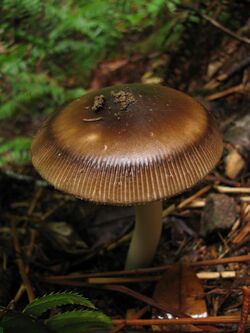Biology:Amanita pachycolea
| Amanita pachycolea | |
|---|---|

| |
| Scientific classification | |
| Domain: | Eukaryota |
| Kingdom: | Fungi |
| Division: | Basidiomycota |
| Class: | Agaricomycetes |
| Order: | Agaricales |
| Family: | Amanitaceae |
| Genus: | Amanita |
| Species: | A. pachycolea
|
| Binomial name | |
| Amanita pachycolea D.E.Stuntz (1982)
| |
| Amanita pachycolea | |
|---|---|
| Mycological characteristics | |
| gills on hymenium | |
| cap is campanulate | |
| hymenium is free or adnate | |
| stipe has a volva | |
| spore print is white | |
| ecology is mycorrhizal | |
| edibility: not recommended | |
Amanita pachycolea, commonly known as the western grisette[1] or the Stuntz's great ringless amanita,[2] is a species of agaric fungus in the family Amanitaceae.
The cap is brown, sometimes lighter near the margin. The gills are white with gray-brown edges, staining orange-brown in age. The stipe is white to brownish with a fibrillose or scaly surface. The base is enclosed by a thick, felty volva, which is white in youth, then yellow or brownish, sometimes becoming reddish in age.[3]
A. pachycolea was recognized as a distinct species by mycologist Daniel Elliot Stuntz, and published in 1982 by Harry Delbert Thiers. It is classified in Amanita section Vaginatae, which includes species with conspicuous radial striations on the cap (8–20 centimetres (3–8 inches) wide), inamyloid spores, and the absence of a ring on the stipe (10–25 cm long, 1–3 cm wide, tapering upward).[4][5]
Found in western North America, it associates with conifers in coniferous and mixed forests. The mushroom is edible, but not recommended due to possible confusion with toxic Amanita species.[1]
See also
References
- ↑ 1.0 1.1 Field Guide to Mushrooms of Western North America. University of California Press. 2012. p. 74. ISBN 978-0-520-95360-4. https://books.google.com/books?id=obp7jddvjt4C&pg=PA74.
- ↑ "Standardized Common Names for Wild Species in Canada". 2020. https://www.wildspecies.ca.
- ↑ Trudell, Steve; Ammirati, Joe (2009). Mushrooms of the Pacific Northwest. Timber Press Field Guides. Portland, OR: Timber Press. pp. 85. ISBN 978-0-88192-935-5. https://books.google.com/books?id=WevHvt6Tr8kC.
- ↑ "New species of Amanita from western North America". Mycotaxon 15: 155–166. 1982. http://www.cybertruffle.org.uk/cyberliber/59575/0015/0155.htm.
- ↑ Davis, R. Michael; Sommer, Robert; Menge, John A. (2012). Field Guide to Mushrooms of Western North America. Berkeley: University of California Press. pp. 74. ISBN 978-0-520-95360-4. OCLC 797915861. https://www.worldcat.org/oclc/797915861.
External links
Wikidata ☰ Q18385205 entry
 |


